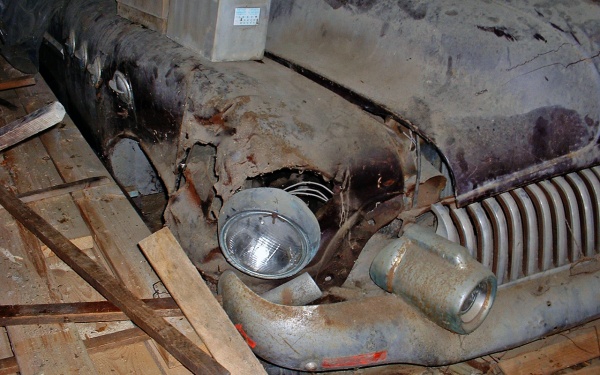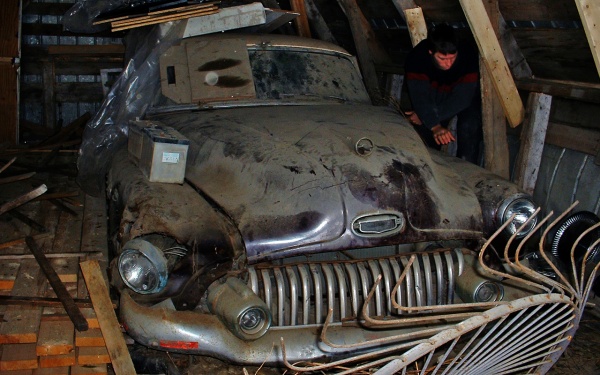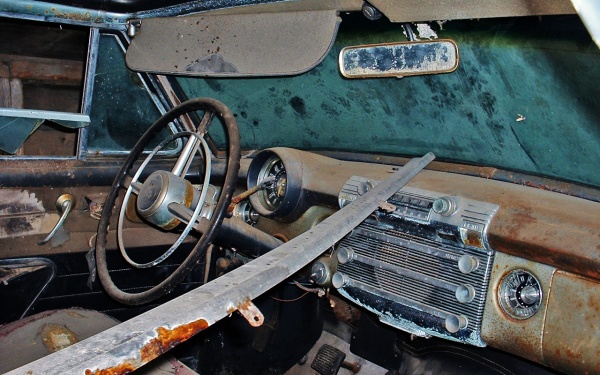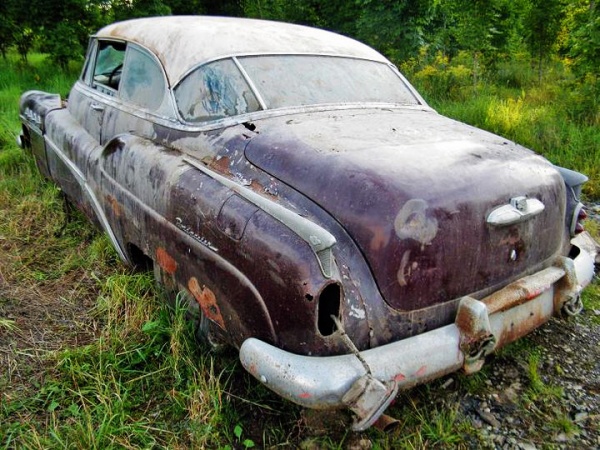
Our astute Cadillac and Buick fans will quickly tell you there is no such thing as a Cadillac Roadmaster and they would be correct, but we can see how one might get their ’50s automotive history and identification skills mixed up. One day reader Mat was talking to his brother-in-law about cars, when his brother-in-law told him about a ’50 Cadillac Roadmaster that was parked in his father’s barn. Obviously he was a bit mixed up on what it was, but it started a conversation that lead to this find. Read Mat’s story in his own words after the jump.

A few years ago, when I met my new brother-in-law, we began talking old cars. He races on small oval tracks, so we share an interest in everything that has 4 wheels and an 8-cylinder engine. He told me his dad had an old 1950’s Cadillac Roadmaster hidden in a barn. Of course my first response was, “Oh, a Cadillac Roadmaster?” He swore that it was a Cadillac, but wasn’t sure about the Roadmaster part. He said it was a two door with two tone paint. Not long after that, I had the opportunity to see the car. Even a Cadillac or a Roadmaster from the 50’s would interest me, but I had no special expectation.

As the barn door opened, I easily recognize the Buick grill, or what was left of it. It is a 1952 two doors hardtop, the Riviera series Roadmaster with the long straight 8. Here’s the story behind it. The previous owner was a doctor and when the car was involved an accident he decided to get a new car and sell it to the father of my brother-in-law, so it sat in their barn since the late 60’s. As a result of the accident it needs a new right fender and most of the grill, but the hood is intact. The car was parked between a bundle of 2×6 boards and the wall of the barn, so I was unable to look under it at that time.

Years later, they decided to move the Buick and I was able to look at it closely. Again, I had no expectation since northern cars with salty roads get rusty all over easily here in Quebec. The car needs a lot of love, there is no impossible project, but this one is too big for me. For example, there is hole behind the back glass that I was able to see the ground under the car. The car is complete except for the passenger fender and the grill that missing a lots of parts. This would have a been great project car but the rust…

And now the long story of why his father still has this old beauty. Back in the 60’s he enjoyed cars a lot. So he began buying cars without any brand preference with the goal to restore them (he had Fords, Edsels, and Chevys). He had a bunch of old cars around the house. One day he had to go out of town for work in northern Ontario for a long time. His father (the grandfather of my brother-in-law) decided that he had had enough of the old cars around the house, so he called a junkyard man to crush all the cars. Somehow the Buick had been forgotten by the father, so it was left untouched by the crusher. The car is now owned by my brother-in-law. He offered to sell it to me only because he knows my passion, but I had to pass on the offer at that point in time. But I told him that if he ever decided to get rid of it to let me know first. This Buick could be a great donor car, but who knows what might happen in the future?


Late 40’s and 50’s Buicks are some dreamy machinery…..just so darn good looking
In the year 1960, a neighbour gave me a 1952 Buick 2 door sedan with the straight 8 engine, and three-on-the-tree transmission, in exchange for re-upholstering four kitchen chairs. I was young at the time, and my parents had no knowledge of the car, which I kept at a friend’s house. This was a perfect running car, with hardly any rust. What I remember most is the hood opened on either side as it was latched, and hinged on both sides. You could unlatch both sides, and remove it. Also, those years were my learn-to-drive years, and often I’d accidently shift the trans into 3rd, instead of 1st, and as I let out the clutch, the car rolled foreward OK, without bucking, but the engine would be brought down to such low RPM that the “GEN” light would come and that told me I had it in the wrong gear. Those straight eights were as smooth as they were strong, thanks to the torque.
I did not understand the connection between Buick and Cadillac. Cadillac was famous for their V8 V12 V16 engines I thought that Buick was the last brand to build straight 8.
The story of that hybrid is fascinating. Hear a straight eight running must be quite an experience. More information would be welcome, I have a strong memory of the Buick in the movie “Rain man” with Dustin Hoffman and Tom Cruise.
My brother-in-law does not know much about old cars. So he thought that it was a Caddilac Roadmaster and I did ask many questions before seeing the car to know wether it was a Caddy or a Buick. If I remember correctly, that Buick was built in USA. And it’s a 52 for sure.
Pontiac made a straight 8 in 54. The last Buick was 53.
Not sure where the Caddy part fits in unless these in Canada were branded as Caddy’s. I would guess this to be a 53.
The Cadillac reference was a joke Paul! The owners son thought it was a Cadillac Roadmaster.
These old straight-8 Buicks always remind me of “Long May You Run”, one of the greatest songs ever written & sung, by Neil Young. Not everyone knows that it was actually about his first car, a 1948 Buick Hearse, named Mort (get it?) that I believe he used during his early days of playing bars in Manitoba, Northern Ontario, and some of the Northern States. There’s even a Wikiedia entry on the song that mentions the Buick.
Anyway, I believe that Young’s ’48 hearse and this ’50s Roadmaster had the same 320 CI straight-8 “Fireball” engine installed. These were pretty understressed and made only about 145 HP, so they lasted a long time if you kept oil and coolant in them, and they made a lot of torque. These weren’t the only straight-8s back then. I learned to drive in my Mother’s 1941 Pontiac straight-8 Coupe with 3-on-the-tree, but that was a flathead, not an OHV like the more advanced Buick 8.
Then there were the exotic Alfa Romeo straight-8 racing engines that were essentially made up of two 4-cylinder engines together in-line with a common crankcase and with the cam drives in the middle between cylinders 4 and 5. This solved most of the problems of having very long camshafts and crankshafts, which would whip (twist) at high RPMs—and these were mainly racing engines. Lots of other straight-8s that I don’t know much about, by Bugatti, Delage, and oh yes, the famous Mercedes 300 SLR used a straight-8 instead of a straight-6 like the road cars.
I like the ususual. 4-cylinder engines have many advantages and have been used far more often than straight-8s, but how can you not like a big 320 CI straight-8 in a Buick, especially when they call the car “Roadmaster” and the engine “Fireball”?
Without that hearse, he may never have met Steven Stills. The rest is most definitely beautiful, if addled, history. Cowgirl in the Sand for me.
I absolutely love these Buicks. I never really liked the Cadillac’s egg crate grill, I always thought the toothy grin nailed it because the bodies were talking in the same curves. Once they started fiddling with headlight surrounds, they lost me.
Great, great find.
Here’s another story about an early-50s straight-8 Buick that I just remembered, told by Peter Egan, best automotive writer I know of, in a story in Road & Track years ago. He and a friend got a car just like this Roadmaster, I think for free. They decided they would turn it into a race car and run it in the stock car races in rural Wisconsin where they were growing up. Since they weren’t experts at tuning engines they decided to add lightness, as Colin Chapman might say, to make it more competitive. They took out as much stuff as they could—seats, door panels, accessories, and anything else that would unscrew or unbolt.
Trouble is, the more they took out the more that Roadmaster rose up on its springs, until it was sitting so high it looked a tad…..ungainly is probably the kindest word. When they took it for a drive the lightened car bounced around so much that they gave up on the idea.
When I first read Egan’s story, once I stopped laughing I remember thinking that their lightened Roadmaster probably rode just like a regular Roadmaster, only more so.
I remember that story. He said the that family dog/cat could run underneath it
& not get grease on its back. Also recall that they tried/succeeded in converting it from a Dynaflow to a manual. No easy feat considering the torque tube rear end.
That Buick 320 Fireball was used in some other applications.
There was a military tank that used the Buick straight for power. In fact I think it used two, one for each track. One could steer the tank with the independent throttles.
One vehicle that many seen, but not everyone knows is powered by a Fireball 320 is the Flexible Clipper Bus that was mostly used by Trailways Bus Company. The Clipper was built from the mid 1930’s to around 1960. The late 30’s models up to the late 50’s models mostly used the Fireball 320 straight 8 for power. It was a pusher style bus with mostly GMC truck running gear. They came with a four speed manual gear box. Those buses would cruise at 70 MPH all day long loaded with 35 passengers.
In the movie RV, the family who lived on the road drove a Clipper.
Buick didn’t provide the engines, but are you thinking of the M18 Hellcat?
http://en.wikipedia.org/wiki/M18_Hellcat
Hay don’t screw with Webby
Actually that was a compliment on Webby’s knowledge.
“A great donor car”?? I don’t see much on that car that is worth keeping. You could do better at almost any swap meet.
Had a friend who had an 1950 Buick Roadmaster ,straight 8 well over 100k on it.and well used one day after a few brews they wondered how long the old girl would last at full bore..so they put a rock on the gas peddle and went on an extended lunch .came back and the old girl was still screaming her guts out . took the rock off the gas and drove her for four more years and gave it away !!
As a young guy, my second car was a ’53 Olds with a ’47 Caddie flathead, I remember the headers were glazed in blue porcelain.
Granted, it would be a huge task, but it’s definitely restorable. This is a very desirable model, and commands big numbers when in nice condition.
That being said, I would do what was necessary to turn it into a driveable dream. Never was one for trailer queens….
I have a 1950 Buick Super Riviera, I would attach a picture, but do not know how.
Ok, I may have been wrong about the tank. That was a story that my father told me, and he is no longer with us. He probably heard the story and just repeated it.
The bus I am sure about. Our fmaily owned one when I was a kid. Dad and I converted it to a motorhome.
http://en.wikipedia.org/wiki/Flxible
https://www.google.com/search?q=flxible+clipper+bus